Pilea peperomioides (Chinese Money Plant) used to be hard to find commercially, but as it was easy to propagate, it was passed on between friends, hence its common names, the Friendship plant, or Pass-It-On plant! This article will help you learn all you need to know about Chinese Money Plant propagation, so you can multiply your collection in no time.
Chinese Money Plant propagation is done by separating plantlets from the rhizome or stem of the parent plant. These can be propagated in water or planted directly in soil. Bright, indirect light, high humidity, and lightly moist conditions will help your plantlets establish themselves and thrive.
Through this article, let us discuss the different ways of propagating this modern, stylish beauty and some nitty-gritties on how to keep the tiny new plants happy.
4 Ways To Propagate Pilea Peperomioides
Did you know that the tiny plantlets that Pileas sprout are also referred to as ‘pups’? How utterly adorable is that!
If your Pilea is healthy and mature, you’re likely to witness many tiny baby plantlets emerging from the main stem or just randomly popping up from the soil within weeks or months of bringing your new plant home.
And once you propagate it successfully, you can pass the daughter plants onto your loved ones where the tiny Pileas can start their own Pilea families, or keep them for yourself to create your own impressive Pilea collection.
I cover all of the Pilea peperomioides propagation methods below, with a step by step written guide, and video tutorial to help you get great results:
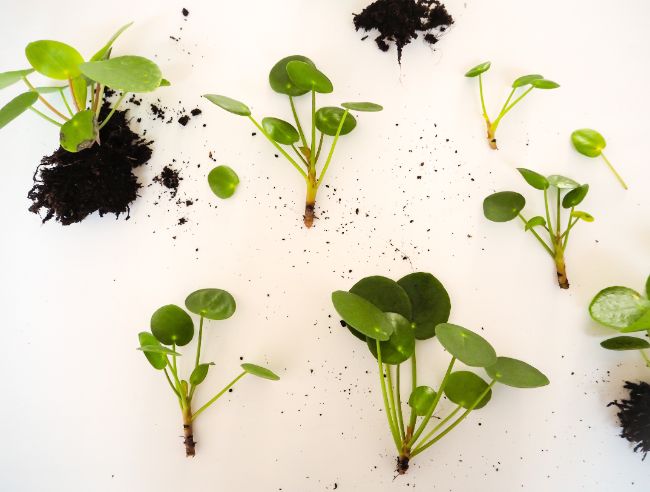
Propagation From Rhizome Plantlets
This is probably the easiest method of Chinese Money Plant propagation. A healthy Pilea plant can have several baby plants emerging from its roots in just a few weeks – each having its own little root system.
Once you notice that your pilea’s root offsets have developed quite a few leaves, it is time to remove them following these simple steps:
- Using your fingers, gently dig the soil (one inch or so) around the baby Pilea and try to disentangle its root system from the mother plant’s.
- In some cases, you might need to take the whole plant out of the container for easy access to the roots of the babies.
- Take a clean blade and carefully separate the baby plants. It’s best to make the cut about an inch (2.5cm) from the base of the stem, taking a section of rhizome and roots with the baby plant. Don’t just pull them out as that might damage their root system.
- As the baby plants have their own root system, you just need to plant them in small containers in a well-draining potting mix.
- Within a few weeks, they should be developing new roots and shortly after growing new leaves.
Propagation From Stem Plantlets
The sight of little Pilea pups shyly peeking out from the mother plant’s stem is enough to melt the toughest of hearts. You will see these growing directly from the main stem of your Chinese Money Plant. These babies, also called stem offsets, can be removed once they are big enough to survive on their own using the following steps:
- Take a clean, sharp knife and gently remove the stem offsets from the mother plant while taking care not to damage the main stem.
- Since the removed plantlets do not have their own root system, you have to either root them in water or in soil and then wait patiently for them to develop roots.
- In the case of water rooting, wait until the roots are at least 1 inch long before planting into soil. This should take approximately 2-4 weeks, depending on lighting and temperature.
- If you root them in soil, you’ll know that your Pilea babies have developed roots when you start noticing new leaves.
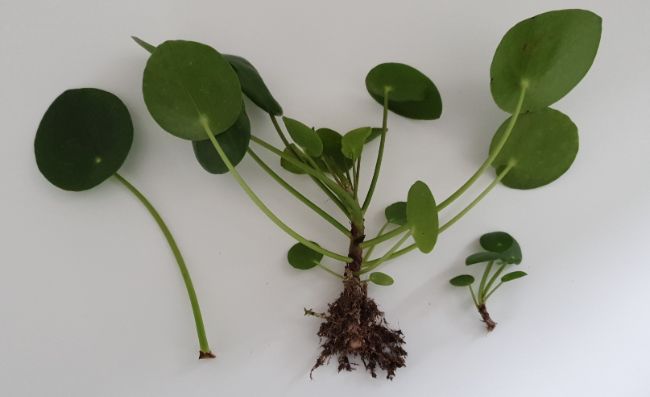
Main Stem Propagation
If your Chinese Money Plant has become tall and leggy, and you want to bring it down to size, stem propagation is a good option to consider. This solves the problem of having to wait a long time for a plantlet to reach maturity and restores your parent plant to a more compact size.
Cut the main stem of your Pilea with a sharp, sterile blade and either plant the stem cutting in soil, or propagate in water. In my experience, water propagation is more effective for large stem cuttings as it reduces the amount of wilting, and provides plenty of hydration while awaiting the development of new roots.
If propagating in water, wait until the roots are several inches in length before transferring to soil, as this will help the plant establish more reliably when potted. This can take upwards of 4-6 weeks, but it is worth being patient to ensure your plant stays healthy.
Does Chinese Money Plant Propagation Work Best In Water Or Soil?
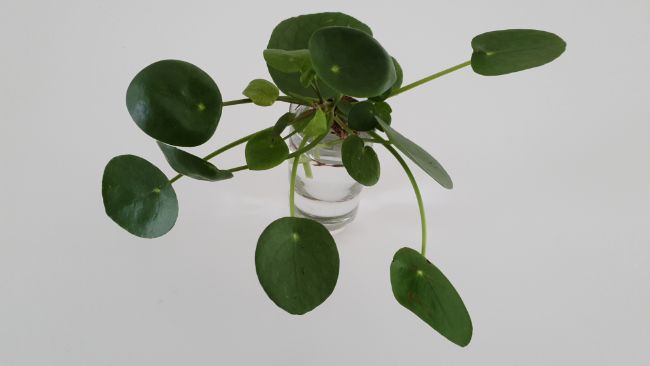
From my own personal experiments, I have found soil propagation to be faster and more reliable for propagating rhizome and stem plantlets. They seem to establish faster and develop roots quicker. This isn’t the case for all houseplants. Vining houseplants such as English Ivy seem to do exceptionally well with water propagation.
The exception to this has been when I have tried to propagate large stem cuttings. These seem to wilt much more when propagated in soil. I assume this is due to the larger amount of foliage that must be supported while new roots are developing.
Thankfully, both methods of propagating Pilea peperomioides work well, and it largely comes down to personal preference. It can be interesting and fun to watch the little roots of your new plants growing in water, and my kids always enjoy checking in on whatever plants I am currently water propagating.
If you’d like to learn more about propagating your houseplants, I’ve written a guide to all the different propagation methods, to get you fully up to speed.
Is It Possible To Propagate Pilea From A Stem Cutting Or Single Leaf?
Some people have reported successfully propagating Pileas from a single leaf. My understanding is that the leaf and petiole do not contain the right plant tissue to be able to grow roots.
However, there is a major caveat to this. If you cut a leaf off along with a small amount of stem tissue, then your cutting will root in water successfully. The image below demonstrates how to take cuttings to propagate single leaves.
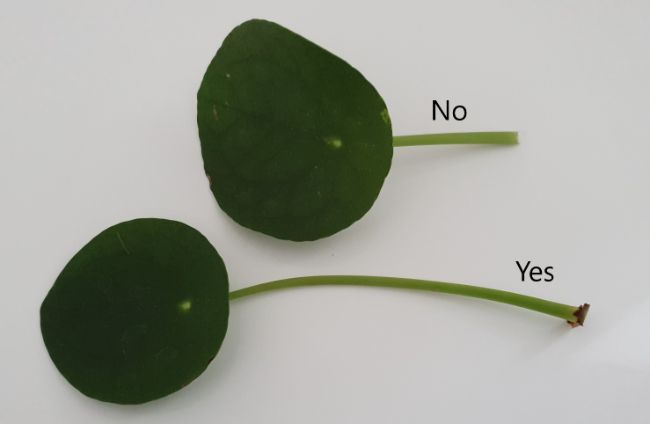
Pilea Peperomioides Propagation Video
This is a video I made that covers everything you need to know about propagating your Chinese Money Plant (Pilea peperomioides), including a step by step demonstration of stem, rhizome, and leaf propagation, in water and soil.
Care Tips After Chinese Money Plant Propagation
Although Chinese Money Plant propagation is pretty easy, the baby plants do require some extra attention if you really want them to thrive.
But don’t worry, even if you consider yourself a lousy plant parent, chances are your baby Pileas are going to grow up just fine if you keep in mind the following points:
When To Propagate Pilea Peperomioides
Yes, you’ll most definitely feel happy as a lark when you spot tiny pups on your Pilea for the very first time, but try to rein in your enthusiasm and wait until the babies are at least 2 to 3 inches tall before separating them from the mother plant.
The best time to propagate this plant is early spring, although you can choose to propagate it any time you want – just make sure to give a little extra attention to the baby plants.
Right Soil Mix For New Pilea
For Pilea pups (or even mature Pileas), it is best to opt for a really well-draining potting mix. Adding plenty of perlite, coarse sand, or gravel to regular potting soil works well. Succulent or cactus potting mix are other good options as they are well-draining and don’t hold too much moisture. Read this article for more info about choosing or making good potting soil.
Pot Requirements
Make sure the pot you plant the baby Pilea in is not too big, as pots that are too large will increase the risk of overwatering and root rot. For a 2-3 inch tall pup, a 2-inch mini pot with one or two drainage holes is ideal. And when you decide to repot, move only one or two sizes up.
Some people prefer terracotta pots for their Pilea plants over plastic or glazed ceramic ones as they facilitate quick evaporation of moisture from the soil.
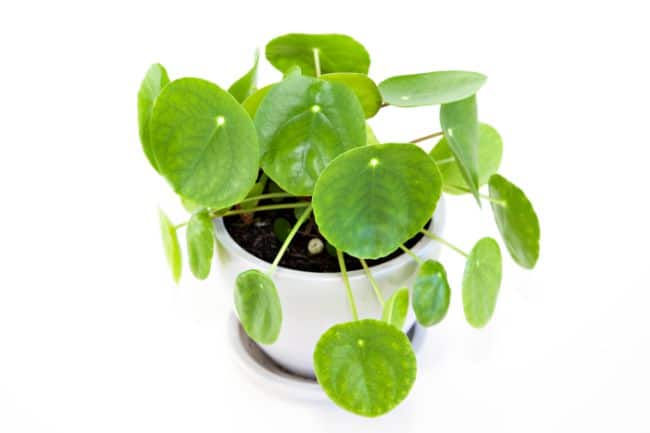
Light And Humidity
Keep your newly propagated Pileas in bright, indirect light – they’ll love it. Choose a windowsill that gets tons of bright light, but avoid excessive direct sunlight, as this can damage the leaves, causing brown scorch marks. And keeping them in a spot that is too shady is going to hinder their growth and greatly increases the risk of propagation failure.
As for humidity, Pileas flourish in humid conditions. Humidity levels of >50% are ideal and will keep the foliage healthy and vibrant. Pilea peperomioides is also a good option for a terrarium, although they will eventually outgrow the space.
Watering Schedule
Pilea plants love moist soil, but it shouldn’t be soggy. Allow the top layer of the soil to dry out completely before watering. Overwatering will most certainly kill the baby plants, so make sure the soil is well-draining and not waterlogged as that would cause the tiny roots to rot.
You may be wondering why a Pilea propagated in soil can be overwatered, and yet one propagated in water does just fine? Does this even make sense? Thankfully, it does, and it has everything to do with oxygen, rather than water.
Roots use oxygen for respiration, and water contains plenty of this. Oxygen from the air enters the water used for water propagation, replenishing it as it is used.
In waterlogged soil, the roots quickly use up the available oxygen and it cannot be replenished. The air-spaces are filled with water, and oxygen from the air cannot get into the soil to replenish the oxygen that is being used.
Eventually, the roots suffocate and root rot sets in. Cutting back on watering and planting in well draining soil ensures your Pilea plantlets don’t succumb to root rot and continue to thrive.
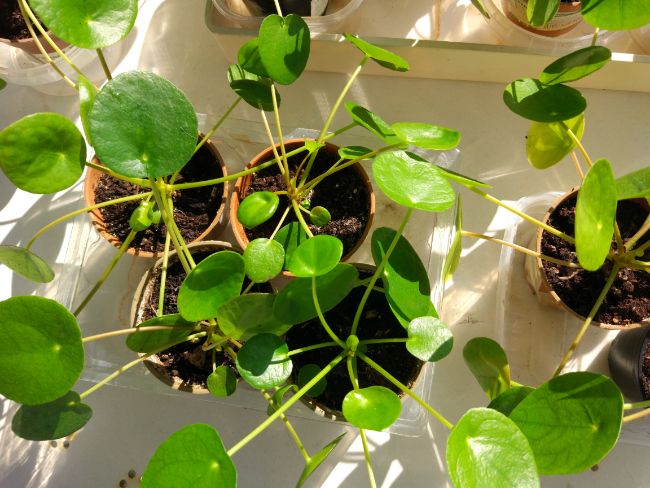
Common Problems After Pilea Propagation
Listed below are some common issues that plant parents might face after propagating their pileas:
Curling/Discoloration of Leaves
If you notice that the leaves on the lower side of your newly propagated pilea plant have started curling, it might imply that you are overwatering the plant. In some cases, overwatering and/or root rot might also cause of discolored or wilting of leaves.
On the other hand, if the upper leaves of the tiny plant are curling inwards or turning brownish, it means that either it is receiving too much direct sun, or it is being exposed to sudden changes in temperature (which is likely if placed in front of heaters or air conditioners).
Droopy Leaves
Droopy leaves on a Pilea most commonly indicate a watering problem. Underwatering is most likely, but overwatering can also cause drooping. check the soil and review how you are looking after your plant to help it perk up again.
Discolored Scars On Leaves
If you notice discolored scars on the leaves of the plant, particularly in winter season, it is because the plant is cold and begging you to be shifted to a warmer room. Remember that Pileas absolutely hate temperatures below 50°F.
Last Word
Pilea peperomioides propagation is a simple and fun way to produce many plants in a short space of time. Pileas are ideal plants for propagation novices, and the fruits of your labor can become gifts for your friends and family.
If you’d like to become an expert in all areas of houseplant care, including propagation, check out my book, Houseplants Made Easy. I’ll help you grow beautifully vibrant houseplants that will thrive year after year, and teach you to identify and fix problems before they threaten the health of your plants.

